|
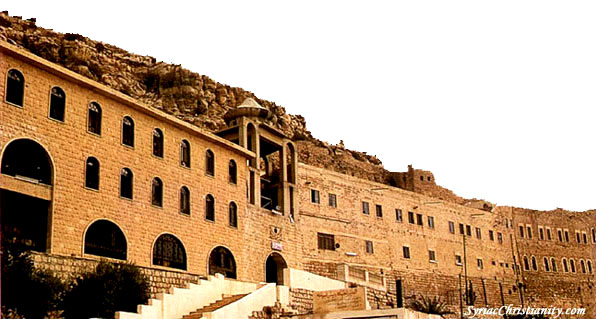 |
|
MOR MATTAI DAYRO The Syriac Orthodox Monastery established in the 4th century
|
In Iraq, monasticism is attested from the 4th century with the coming of monks from the West; that is from today’s eastern Turkey. Because of persecutions (521-65) other monks from Amid fled and settled in the area called Beth Arabaye, west of Mosul. Ancient Syrian Orthodox monasteries have been listed mainly around Mosul. The Jabal Maqlub, about 30 kilometers north east of Mosul, is also called the ‘Mount of the Thousands’, because of the great number of monks and hermits living there when monastic life was very vigorous between the 4th and the 8th centuries.
The main monastery there is dedicated to 'MOR MATTAI', Saint Matthew. It is superbly situated, looking out from the mountainside towards the Tigris and the Mesopotamian plain.
The monastery has an Episcopal seat, and, from time to time, it has even become the See of the Maphrian. Maphryono Mor Gregorius Bar `Ebroyo resided there from 1264. He is buried there together with other bishops and with Mor Mattai the founder. Their relics are venerated in a special room (beth qadishe) next to the main church. Mor Mattai Monastery is always regarded as a holy place. Even now pilgrims collect soil from the ground as blessing.
Mor Mattai Dayro is the oldest Syrian Orthodox monastery in north east Mesopotamia. In 629 the monastery received the primacy over the monasteries of Persia. It is said that Saint Mattai was born near Amid (Diyarbaker) around the beginning of the 4th century. After the persecution of Julian the Apostate (c.361) he settled on a mountain near Nineveh, (near modern Mosul). He healed the sick. According to tradition, he converted the son of the king of Assyria, Behnam, and his daughter Sarah, to Christianity; consequently Sarah’s leprosy disappeared.
In the present buildings of Mor Mattai monastery some of the lower church walls apparently date back to the 12th/13th century. The main church is dedicated to Mor Mattai and another one is dedicated to the Virgin Mary. It is recorded that Claudius James Rich, the British consul in Baghdad had visited Mor Mattai in 1820. In 1843 Rev G P Badger found Mor Mattai monastery damaged. In 1892, O H Parry found that the repair works noted by Budge some years were still going on.
Mor Mattai Dayro & its rich heritage 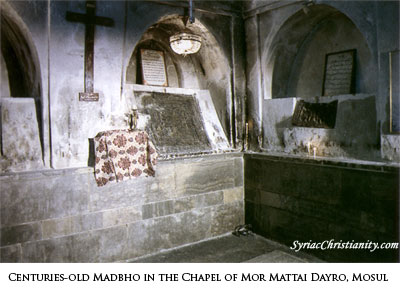
This monastery established in the 4th century, came to be well known by the sixth and seventh centuries, when it was the most important Syrian Orthodox centre in north Iraq, with a resident bishop (whose title included Nineveh, ie.Mosul). By about 800 the monastery’s library had assembled an extremely fine collection of manuscripts. A number of manuscripts copied at Mor Mattai survive to this day; the most important among which is a gospel lectionary accompanied by a very extensive series of 50 illustrations of episodes from the life of Christ. The name of the artist is not given, but the scribe was Mubarak, from the town of Bartelli. The person who commissioned this wonderful monument of medieval Syriac illumination was the head man ‘Abdallah. The date was for a long time thought to be 1220, but it has recently been pointed out that it would be better to read it as 1260. In view of this it is very likely that, in the picture of the emperor Constantine and his mother Helen, the face of Helen is in fact a portrait of Queen Doquz Khatun, the Christian wife of the Mongol II-Khan Hulagu.
It was like wise Bartelli (a nearby town) which produced at about the same time the most famous of all the bishops of Mor Mattai, the learned scholar Mor Severus Ya’qub bar Shakko (d.1241). The earlier part of the thirteenth century was clearly a time when the intellectual and artistic life of the monastery flourished; according to the Arab geographer Yaqut, it had about a hundred monks at this time. Around 1155, Mor Mattai Dayro becomes the seat of the Maphrians’ after the second aggression on Tikrit by the Arabs. (The Maphrianate of the East, founded in 629 by the Patriarch of Antioch & all the East, to take care of the Syrian Orthodox living in the dioceses situated in the ancient territory of the Persian Sassanid Empire, was centered around Tikrit/Tigris until then). The political disturbance of early Mongol rule, however, brought troubled times, and in 1269 the monastery was sacked by raiders – the first of several it was to suffer in the next centuries. But the Maphrianate remained there (or sometimes in Mosul and near by Monasteries) until it ceased to exist in 1860. Despite all setbacks the monastery has always maintained its importance and continues in existence to this day when, in recent years, much restoration work has been undertaken.
Near the monastery one can see the cave of Mor Mattai. In other caves around many hermits used to live, the names of whom are remembered, for examples; Zakkai, Issac, Bar Hebraeus himself, Ibn al-Khiate (the son of the tailor), Ibn al-Sabaghe (the son of the dyer). One place is called ‘ruak al malak’, that is the passage of the angel. Also near the Mor Mattai Dayro traces are left of ancient monasteries, now destroyed, such as Kukhta, Mor Abraham, Mor Yohannan of Barazi and Mor Yohannan Et Izo Sawra.
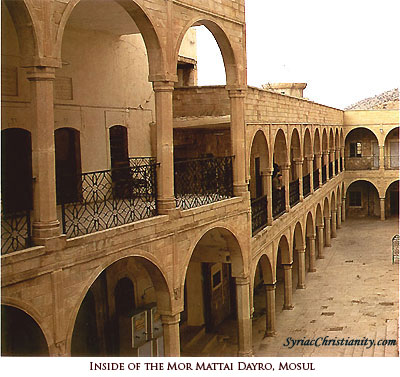 |
Nearby churches
Mor Dioscorous Louca Shaya, the abbot of Mor Mattai Monastery, is the present Metropolitan of the villages around the monastery. The Archdiocese of the Monastery of Mor Mattai includes the towns of Bartalla, Bashiqa and Bahzani.
Bartalla is situated about 15 kilometers from
Mosul, half way to Mor Mattai Monastery with which it always had strong links.
It is a very ancient Syrian Orthodox site. The history of Marutha speaks of its
church school. The famous scholar Mor Severus Ya’qub bar Shakko, bishop of Mor
Mattai and Azerbaijan from 1232 to 1241 was from Bartalla, as was Gregorios
Yohannan (died before 1269), bishop of Azerbaijan. The most well known Maphrian,
Mor Gregorius Bar `Ebroyo
(1264-86) lived mostly in Mor Mattai
Monastery, but he also took care of Bartalla. Patriarch Ignatius Yakub III
wrote about the 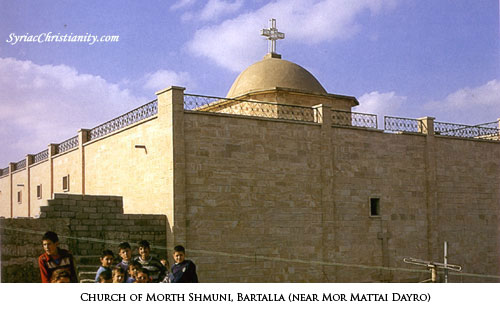 Syrian Orthodox Patriarchs originating from Bartalla, and a
Patriarch Barsoum gave a list of its famous copyists and medical doctors. The
two most active Syriac Orthodox churches in Bartalla are the 15th
century St. Mary’s Church and the Morth Shmuni church, with the relics of Mor
Ahudemmeh and Yohannan bar Naggare. There one can see a baptismal
font dated 1343. The people of Bartalla continue to speak, Sureth, a
Syriac dialect.
Syrian Orthodox Patriarchs originating from Bartalla, and a
Patriarch Barsoum gave a list of its famous copyists and medical doctors. The
two most active Syriac Orthodox churches in Bartalla are the 15th
century St. Mary’s Church and the Morth Shmuni church, with the relics of Mor
Ahudemmeh and Yohannan bar Naggare. There one can see a baptismal
font dated 1343. The people of Bartalla continue to speak, Sureth, a
Syriac dialect.
The town of Bashiqa is situated 21 kilometers north east of Mosul and 11 kilometers north west of Bartalla, with 30 % of the population being Syrian Orthodox. It was here a famous school was founded around 630 by Sabrio. The church here is dedicated to Marth Shmuni. In recent times it was restored in 1890 and again in 1989. (The famous church dedicated to Marth Shmuni, that is St.Shmuni and her seven martyred sons, is in the village of Karakkosh, situated south east of Mosul and includes in the Archdiocese of Mosul).
Bahzani, the other village under the diocese of Mor Mattai Monastery is situated one and half kilometers away from Bashiqa. Here the main church is dedicated to Saint George.
At the foot of Mor Mattai monastery, the village of Merga is inhabited by Syrian Orthodox. It has one church dedicated to Mor Mattai. From there pilgrims used to walk up to Mor Mattai Monastery. This Monastery in its long history has produced two Patriarchs of the See of Antioch, seven Maphrian (Maphryono) and twenty four Metropolitans.
|
Location Map of the Mor Mattai Dayro |
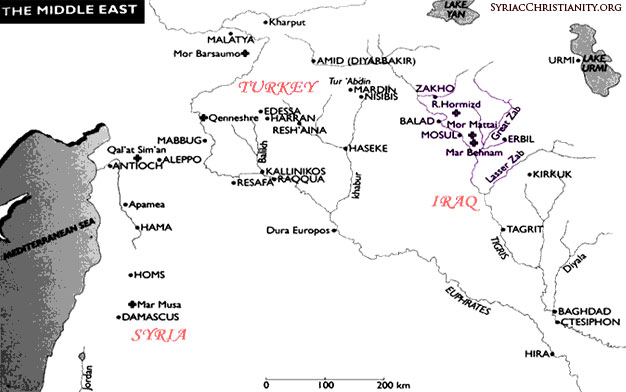 |
Related Links:
The Syriac Orthodox Resources web site, http://sor.cua.edu/ChMon/MosulDMattay/index.html
Main source:
Christine Chaillot, 'The Syrian Orthodox Church of Antioch and All the East, A Brief Introduction to its Life and Spirituality', Geneva 1998.
Other References:
S P Brock, 'The Hidden Pearl' (2001), Very Rev Kurian Corepiscopa Kaniamparambil, Suryani Sabha, 1982
|
This is not an official site of Mor Mattai Dayro, Mosul |